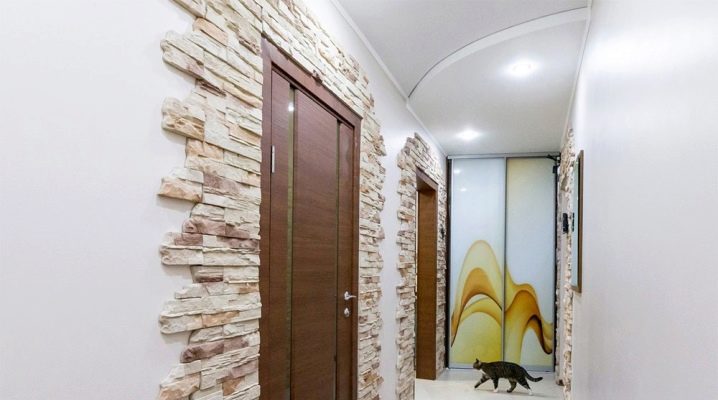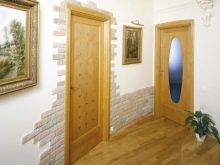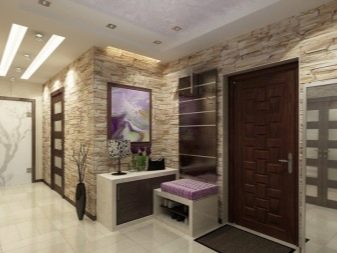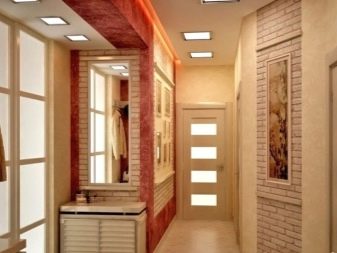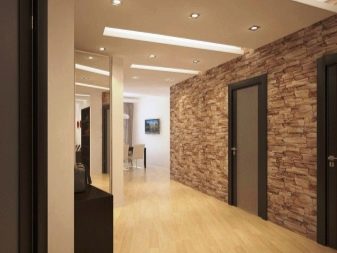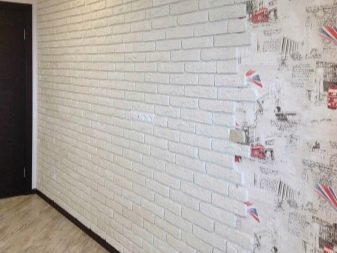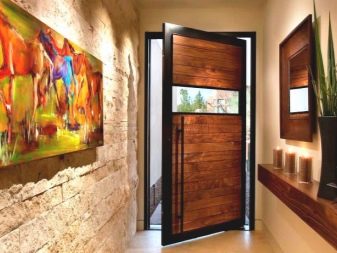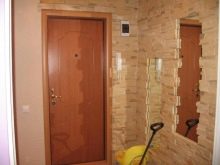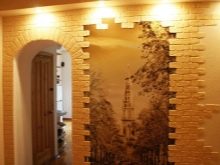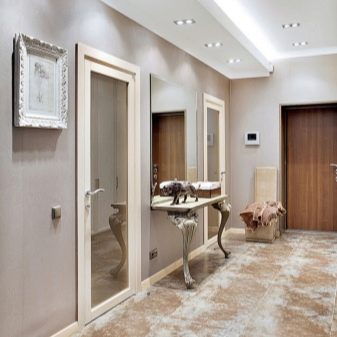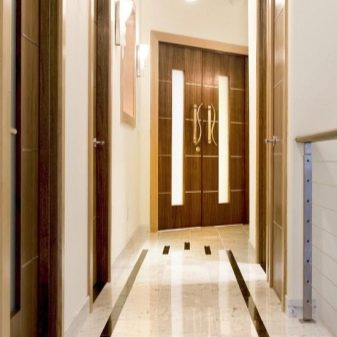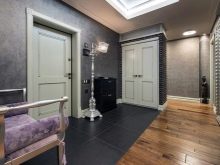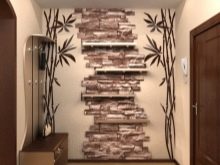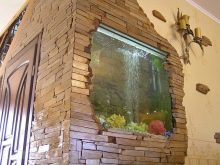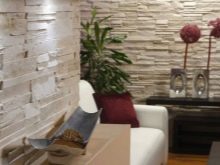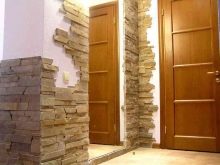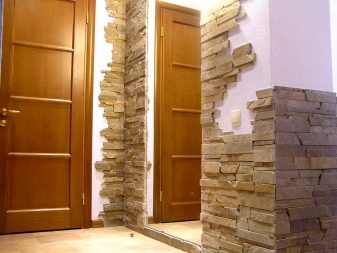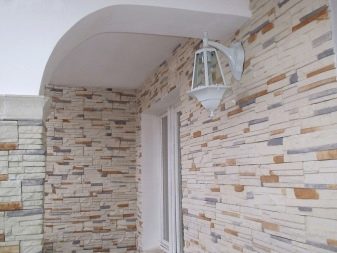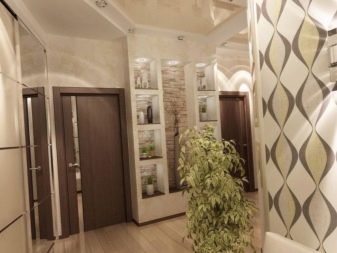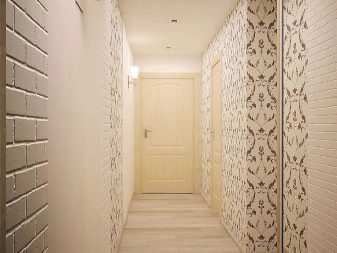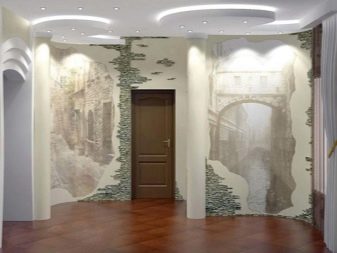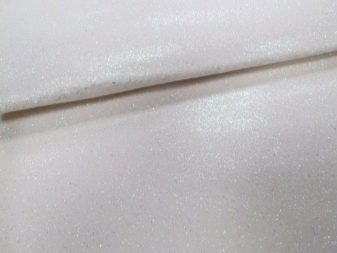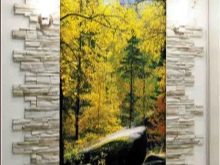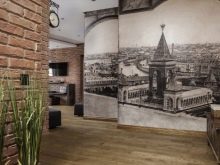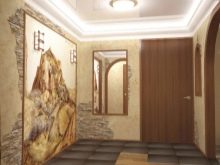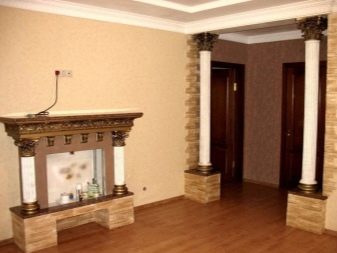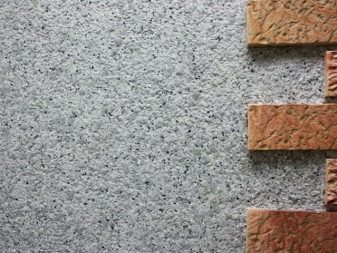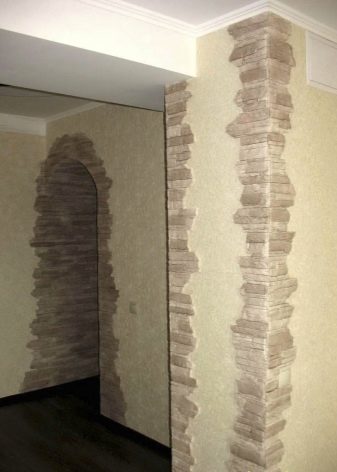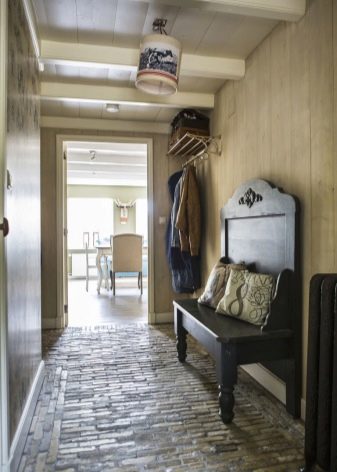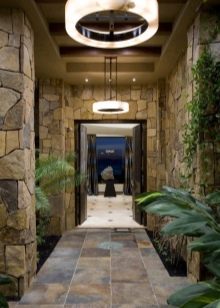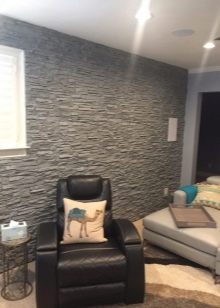Decorating the hallway with decorative stone and wallpaper
A few seconds in the hallway - this is the time when we, under the influence of the first impression, decide whether we feel comfortable in this house or uncomfortable. That is why you should pay special attention to the decoration and design of the input space. Decorative stone or suitable wallpaper can help to make the hall functional and beautiful.
Benefits
Stone is a material used by man since ancient times. Stone walls have a unique texture, they are incredibly durable and have high insulating properties. The stone is resistant to temperature changes and is an ideal choice for hot spots, such as fireplaces or stoves.
Interior stone finish looks great. It gives the room a royal look.
Ecologically safe and reliable internal stone walls are resistant to high humidity, they are wear-resistant, fire-resistant and resistant to mold. The stone has the longest service life of all finishing materials. Finally, servicing the internal stone walls is very simple. Sometimes it is enough to wipe them with a damp cloth or use mild detergents. In order not to damage the stone walls and not to destroy the beauty of the finish, do not clean them with metal brushes or abrasives.
Stone, terracotta and ceramic tiles are ideal for flooring in the hallway, as they are resistant to scratches, scuffing and dirt.
Wallpapers, like stone, are a popular choice for decorating a hallway. With their help, you can "play" with the input space or link the color schemes of adjacent rooms. Wallpapers are poor conductors of heat, which makes them good temperature regulators: they help to keep warm in cold weather and cool in hot days. In addition, the wallpaper hide small defects, such as cracks and irregularities. Wallpapers can be used to decorate walls, ceilings, or even furniture.They can be used on a wide range of surfaces, including wood, tiles, stone and even synthetic material.
Stone types
Many people ask themselves whether it is worth buying a natural stone or choosing an artificial one. Let's evaluate their pros and cons.
Natural stone is environmentally friendly and aesthetic. It has a natural, unprocessed appearance, which adds to the interior of naturalness. The quality of natural stone, its natural beauty and unusual structure make it very attractive for use, despite the high cost. Another obstacle may be that it is a very heavy material for finishing.
- Granite - extremely solid, durable stone, available in a huge variety of colors. Durability makes it an ideal material for such intensively used surfaces as floors and kitchen worktops. Granite successfully resists high temperature, it is almost impossible to scratch it, it does not leave stains from citric acid, coffee, tea, alcohol.
- Marble - an elegant, classic material that has been used for thousands of years.White marble is most popular, but there are many other color options. Because marble is softer than granite, it is less resistant to stains and scratches. It should be borne in mind that over time a patina forms on the marble (slight change in color or texture).
- Travertine, limestone, soapstone, sandstone widely used as a finishing stone for flooring, interior and exterior wall cladding, fireplaces, chimneys, outdoor paving.
- Fake diamondwhich is cast in molds (usually a mixture of cement, aggregates and iron oxides), can be much easier than natural. This is an advantage, since it does not weigh down the walls and is easier to install on your own. Artificial stone manufacturing techniques are constantly being improved, and from a distance the difference between it and natural stone is almost invisible. In addition, this material has excellent performance, fire resistance and low cost. However, the product of mass production is not able to create the feeling of “one of a kind” inherent in natural stone.
However, since it is extremely important today to cut costs wherever possible, designers are increasingly using artificial materials. The current economic climate, limited access to credit, lower incomes - all this means that designers must compete in a tough buying market. However, customers still demand high quality and unbreakable beauty.
This dilemma helps to solve new modern artificial materials, such as stone veneer, sometimes called artificial stone, or veneer. This material makes it possible to implement fresh innovative projects due to the high variability of its use and cost reduction. Variability is associated with the ability of the material to be cut into pieces of various shapes and sizes.
Decorative stone veneers are designed for interior walls or fireplaces. They add style to the room by imitating the look and texture of natural stone. Some decorative stone veneers are made in the form of panels to speed up and simplify installation, others are in the form of individual parts.
Facing panels made of artificial stone are made of waterproof high density polyurethane. To add color to the polyurethane, color oxides are added. This combination of materials is subjected to compression under high pressure in the forms of stone, rock, or brick, resulting in a dense, realistic-looking ready-made panel of artificial stone.
Beauty, gorgeous appearance, natural color and texture - these are the attributes of the interior walls, decorated with artificial stone veneer. They are easy to maintain and do not lose their appearance over a long period of time.
Wallpaper types
Traditional wallpaper can be single (simplex) or double (duplex). They are very popular, but fade in the sun and do not wash. Some species are not resistant to moisture, so they are difficult to apply on the wall without washing off some of the paint.
A very popular type of wallpaper is vinyl. They consist of a layer of substrate, paper or fiber, and a plastic top coat. Their advantages are obvious: they are washable, lightweight, relatively cheap and extremely durable, which makes them ideal for use in frequently visited rooms (kitchens, dining rooms, bathrooms).
They should be changed only in 10-20 years.Vinyl wallpapers vary greatly in color and pattern, they can mimic wood, stone, concrete, and more. However, they do not allow walls to breathe, they can release toxic fumes, so they cannot be used in bedrooms and poorly ventilated rooms.
Embossed wallpapers can hide defects of the wall: scratches, cracks and roughness. The disadvantages are as follows: they are difficult to glue carefully (because over time the edges will start to bend and peel), it is also difficult to peel them off the wall: you risk damaging the plaster.
Non-woven wallpaper resistant to tearing. This is a great advantage because they are not damaged when glued or removed. Today it is the most comfortable and environmentally friendly wallpaper on the market. They are incredibly light, perfectly glued with little effort. This type of wallpaper does not expand and does not shrink, so they do not change their size over time. It can also be used as a basis for painting. However, non-woven wallpaper is expensive and not washable.
Today's wallpapers allow designers and homeowners to use personal photos, drawings, landscapes and scenes on the walls.Modern wall murals are self-adhesive and reusable.
Designers use them for residential and commercial projects, indoor and outdoor spaces. The size of the room is essential when deciding on their use. Wall mural require sufficient distance to look good, because they usually create a kind of theatrical background. Near we do not see the overall composition. Looking at the details will not give the desired effect. The atmosphere of the room is also important. What you usually do in it: work, eat, sleep, all these questions are important for choosing a theme or a style of photo wallpaper.
Liquid wallpaper is a wall and ceiling surface that is environmentally friendly because it is made from recycled fibers. Before application it is required to add only water. Of course, this coating is a very practical option, because it does not contain chemicals, can be used on any wall and hides the flaws of the plaster. It is applied with a spatula, and not glued like normal wallpaper, which provides a smooth finish without joints or seams, and also eliminates the need to match images on different pieces, which is a problem for ordinary wallpaper.
This coating is easily applied to the surface of bay windows, arches and pipes, where ordinary wallpaper is not applicable. It can be used almost everywhere, even in rooms with a high percentage of humidity and unstable temperature.
A significant advantage is that it is easy to repair. When the walls of the house shrink or expand under the influence of heat or cold, small gaps in the cover can potentially occur with time. There is a simple solution to the problem: using a bottle of water, a spray gun and a spatula, any cracks can be smoothed out in seconds.
Liquid wall coverings provide the perfect combination with other finishing materials: cork, paint, other decorative materials to cover walls and decorative plaster, wallpaper, stone, and so on, allowing you to create an economical modern and exclusive interior design.
Beautiful interior design options
- Wallpaper with a large pattern on an inclined surface creates an interesting contrast with the geometric pattern of the walls. The white base visually expands the compact space. The painted chair and lamp make this area the focal point of the hall.
- Brick floor gives the individuality of the hallway in a country house.
- The warm light of the built-in lamps allows the texture of the “wild” stone to open up and play, and the penumbra from pendant lamps add to the room fabulousness and mysticism. For the flooring selected slate with a rust shade, which blends well with the color of the walls.
- Light brick walls and hanging lighting can even make a narrow corridor in the Khrushchev impressive.
- Panels imitating ancient stone walls have turned an ordinary living room into an interesting, attractive place where you want to stay longer.
How to properly lay a decorative stone on the wall, see the following video.
